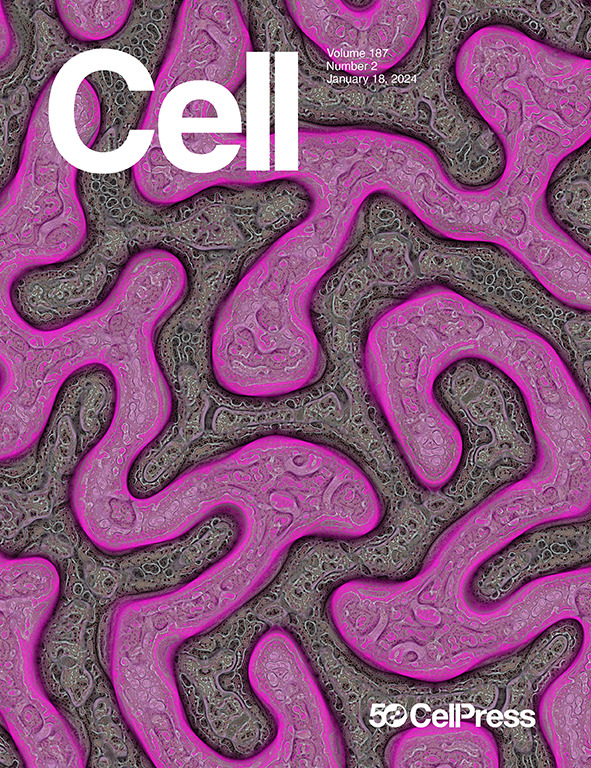整合生殖状态和社会线索控制社会性行为
IF 42.5
1区 生物学
Q1 BIOCHEMISTRY & MOLECULAR BIOLOGY
引用次数: 0
摘要
女性的社会性行为对生存和繁殖至关重要,受卵巢激素的调节,并在适当的社会线索的背景下触发。在这里,我们发现初级发情敏感的表达cacna1h的内侧前额叶皮层(mPFCCacna1h+)神经元整合了激素状态和对潜在伴侣的识别,以协调这些复杂的认知行为。mPFCCacna1h+神经元的双向操纵通过下丘脑前部输出改变雌性发情期和退情期异性导向的社会行为。在雄性中,这些神经元的功能与发情期的雌性相反。微镜成像显示不同mPFCCacna1h+亚群的自我发情状态和社会目标性别的混合表征,在发情的雌性和雄性中存在异性信号的偏编码。机制上,卵巢激素诱导的Cacna1h上调可增强催产素抑制后的t型反弹兴奋,驱动发情特异性活性改变和mPFCCacna1h+神经元的性二态功能。这些发现揭示了一个前额回路,它整合了内部荷尔蒙状态和目标性别信息,从而对适应性社会行为施加自上而下的性双价控制。本文章由计算机程序翻译,如有差异,请以英文原文为准。

Integrating reproductive states and social cues in the control of sociosexual behaviors
Female sociosexual behaviors, essential for survival and reproduction, are modulated by ovarian hormones and triggered in the context of appropriate social cues. Here, we identify primary estrous-sensitive Cacna1h-expressing medial prefrontal cortex (mPFCCacna1h+) neurons that integrate hormonal states with recognition of potential mates to orchestrate these complex cognitive behaviors. Bidirectional manipulation of mPFCCacna1h+ neurons shifts opposite-sex-directed social behaviors between estrus and diestrus females via anterior hypothalamic outputs. In males, these neurons serve opposite functions compared with estrus females. Miniscope imaging reveals mixed representation of self-estrous states and social target sex in distinct mPFCCacna1h+ subpopulations, with biased encoding of opposite-sex cues in estrus females and males. Mechanistically, ovarian-hormone-induced Cacna1h upregulation enhances T-type rebound excitation after oxytocin inhibition, driving estrus-specific activity changes and the sexually dimorphic function of mPFCCacna1h+ neurons. These findings uncover a prefrontal circuit that integrates internal hormonal states and target-sex information to exert sexually bivalent top-down control over adaptive social behaviors.
求助全文
通过发布文献求助,成功后即可免费获取论文全文。
去求助
来源期刊

Cell
生物-生化与分子生物学
CiteScore
110.00
自引率
0.80%
发文量
396
审稿时长
2 months
期刊介绍:
Cells is an international, peer-reviewed, open access journal that focuses on cell biology, molecular biology, and biophysics. It is affiliated with several societies, including the Spanish Society for Biochemistry and Molecular Biology (SEBBM), Nordic Autophagy Society (NAS), Spanish Society of Hematology and Hemotherapy (SEHH), and Society for Regenerative Medicine (Russian Federation) (RPO).
The journal publishes research findings of significant importance in various areas of experimental biology, such as cell biology, molecular biology, neuroscience, immunology, virology, microbiology, cancer, human genetics, systems biology, signaling, and disease mechanisms and therapeutics. The primary criterion for considering papers is whether the results contribute to significant conceptual advances or raise thought-provoking questions and hypotheses related to interesting and important biological inquiries.
In addition to primary research articles presented in four formats, Cells also features review and opinion articles in its "leading edge" section, discussing recent research advancements and topics of interest to its wide readership.
 求助内容:
求助内容: 应助结果提醒方式:
应助结果提醒方式:


